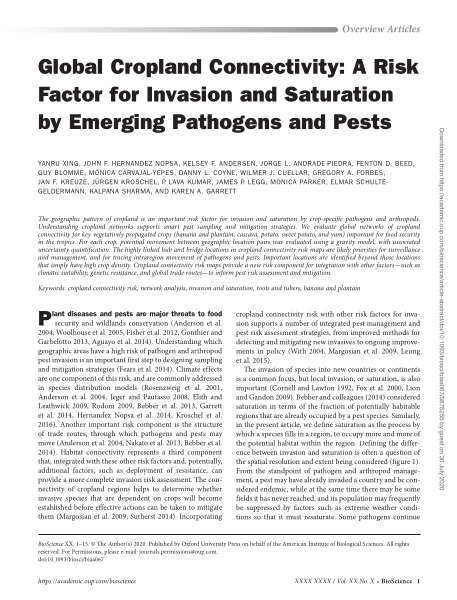The geographic pattern of cropland is an important risk factor for invasion and saturation by crop-specific pathogens and arthropods. Understanding cropland networks supports smart pest sampling and mitigation strategies. We evaluate global networks of cropland connectivity for key vegetatively propagated crops (banana and plantain, cassava, potato, sweet potato, and yam) important for food security in the tropics. For each crop, potential movement between geographic location pairs was evaluated using a gravity model, with associated uncertainty quantification. The highly linked hub and bridge locations in cropland connectivity risk maps are likely priorities for surveillance and management, and for tracing intraregion movement of pathogens and pests. Important locations are identified beyond those locations that simply have high crop density. Cropland connectivity risk maps provide a new risk component for integration with other factors—such as climatic suitability, genetic resistance, and global trade routes—to inform pest risk assessment and mitigation.
Global cropland connectivity: A risk factor for invasion and saturation by emerging pathogens and pests
Citation: Xing, Y.; Hernández Nopsa, J.F.; Andersen, K.F.; Andrade-Piedra, J.L.; Beed, F.; Blomme, G.; Carvajal-Yepes, M.; Coyne, D.; Cuéllar, W.; Forbes, G.; Kreuze, J.F.; Kroschel, J.; Kumar, P.L.; Legg, J.P.; Parker, M.; Schulte-Geldermann, E.; Sharma, K.; Garrett, K.A. (2020) Global cropland connectivity: A risk factor for invasion and saturation by emerging pathogens and pests. BioScience. ISSN 1525-3244. Published online 29Jul2020.
2020-08-05
BIODIVERSITY FOR THE FUTURE, CROP AND SYSTEMS SCIENCES CSS, CROP PROTECTION, POTATO AGRI-FOOD SYSTEMS, POTATOES, SWEETPOTATO AGRI-FOOD SYSTEMS, SWEETPOTATOES
AFRICA
journal_article

